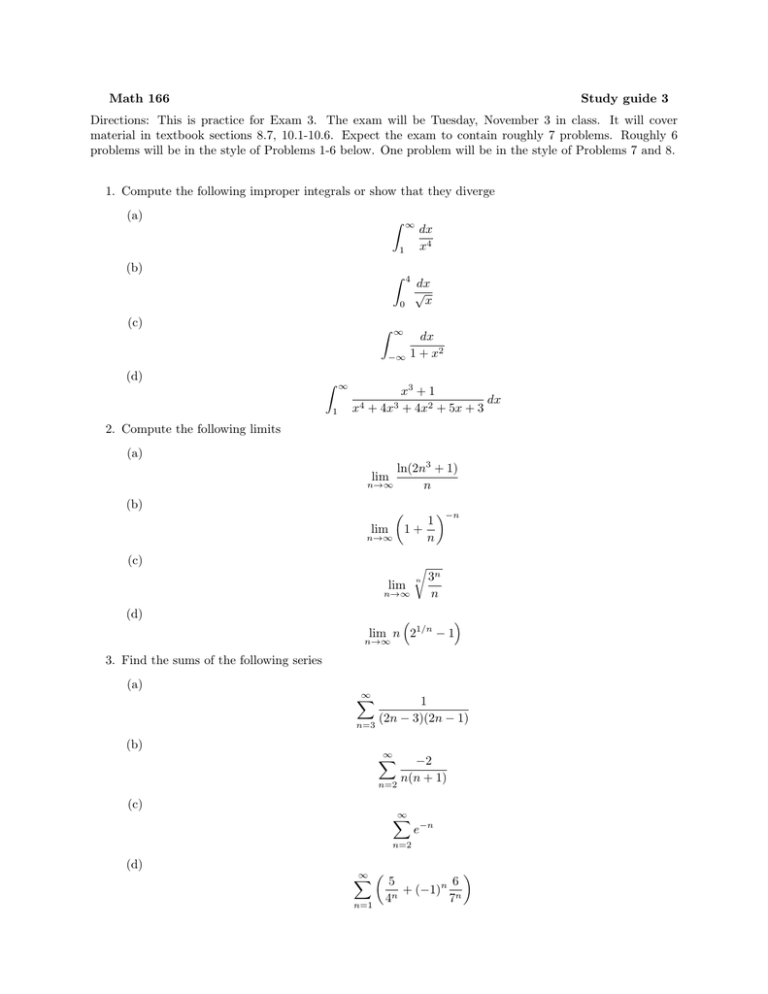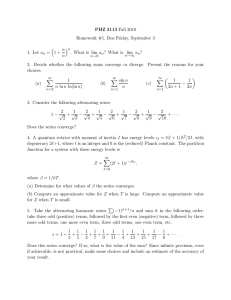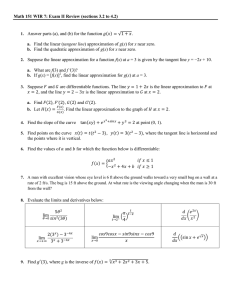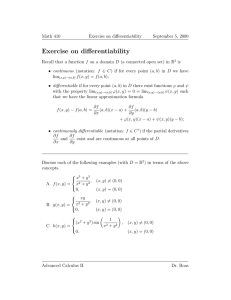Math 166 Study guide 3
advertisement

Math 166 Study guide 3 Directions: This is practice for Exam 3. The exam will be Tuesday, November 3 in class. It will cover material in textbook sections 8.7, 10.1-10.6. Expect the exam to contain roughly 7 problems. Roughly 6 problems will be in the style of Problems 1-6 below. One problem will be in the style of Problems 7 and 8. 1. Compute the following improper integrals or show that they diverge (a) ∞ Z 1 dx x4 (b) 4 Z 0 (c) ∞ Z −∞ dx √ x dx 1 + x2 (d) Z 1 ∞ x3 + 1 dx x4 + 4x3 + 4x2 + 5x + 3 2. Compute the following limits (a) ln(2n3 + 1) n→∞ n lim (b) lim n→∞ 1 1+ n −n (c) r lim n→∞ n 3n n (d) lim n 21/n − 1 n→∞ 3. Find the sums of the following series (a) ∞ X 1 (2n − 3)(2n − 1) n=3 (b) ∞ X −2 n(n + 1) n=2 (c) ∞ X e−n n=2 (d) ∞ X 5 n 6 + (−1) n 4n 7 n=1 (e) ∞ X 1 n=0 2n+2 4. Determine whether the following series converge. (a) ∞ X 1 √ n n=1 (b) ∞ X ln n n n=1 (c) ∞ X 2n 3 + 4n n=1 (d) ∞ X n=1 (n2 n(n2 + 1) + 1)(n4 − 1) (e) ∞ X n(n + 1) n2 − 1 n=1 (f) ∞ X (ln n)3 n5 n=1 5. Determine whether the following series converge (a) ∞ X 2n n! n=1 (b) ∞ X n2 e−n n=1 (c) ∞ X n5n (2n + 3) ln(n + 1) n=1 (d) ∞ X 7 (2n + 5)n n=1 (e) n ∞ X 4n + 3 n=1 3n − 5 (f) −n ∞ X 1 1+ n n=1 6. Which of the following series converge? Of those that converge, which converge absolutely? (a) ∞ X 1 (−1)n √ n n=1 (b) ∞ X (−1)n n=1 ln n n (c) ∞ X (−1)n n=1 n4 n2 + 1 + n2 + 5 (d) ∞ X (−1)n+1 n=1 3+n 5+n Error estimates for series with positive terms Let an = f (n) P for all n ≥ 1, where f is a continuous, Pnpositive, decreasing function defined on [1, ∞). ∞ Suppose that a converges to S. Let s = k n k= k=1 ak . We showed that the remainder Rn = P∞ a satisfies the inequality k k=n+1 Z ∞ Z ∞ f (x) dx ≤ Rn ≤ n+1 f (x) dx. n One should note that Rn = S − sn , which is why it makes sense to think of Rn as the error in using sn as an estimate for S. Consider the following example. Let f (x) = 1/x2 and consider P∞ k=1 1/k 2 . One can easily compute s10 = 1 + 1/4 + 1/9 + 1/16 + 1/25 + 1/36 + 1/49 + 1/64 + 1/81 + 1/100 P∞ with a calculator and think of s10 as an approximation for the entire sum S = k=1 1/k 2 . However, this approximation is made much more meaningful if one can say something about the error R10 in the approximation. The above inequality does this for us: it tells us that Z ∞ R10 ≤ 10 b 1 1 1 dx −1 = lim −x = lim − − . = b→∞ b→∞ x2 b 10 10 10 One can also turn this around and ask for n so that the error Rn is at most some small number like 10−5 . Note that Z b Z ∞ dx 1 1 1 dx = lim = lim − − = Rn ≤ 2 2 b→∞ n x b→∞ x b n n n So if we can find n so that 1/(n) ≤ 10−5 we will be done. Of course n ≥ 105 works. 7. Consider the convergent infinite series S = P4 (a) Compute s4 = n=1 n13 . P∞ 1 n=1 n3 . (b) Think of s4 as an approximation for S. Find an upper bound for the error in this approximation. (c) Find the smallest integer n so that the error in using sn as an approximation for S is less than 10−7 . Error estimates for alternating series The previous method only works for error estimates in series with positive terms. For alternating series, P∞ we have the following error estimate. Consider a convergent alternating series of the form n=1 (−1)n an converging to S. Again, let Rn = S − sn denote the error in using sn as an approximation for S. Then |Rn | ≤ an+1 . P∞ n+1 1 Consider the alternating series n=1 (−1) n2 . This series of course converges (by the absolute convergence test), say to S. One can use a calculator to compute s4 = 1 − 1 1 1 + − . 4 9 16 We can think of s4 as an approximation for S. We’d like to know the error in this approximation. This is precisely R4 = S − s4 . The issue is that we don’t know what S is. However, we know that |R4 | ≤ a5 = 1/52 = 1/25. So the error in using s4 as an estimate for the entire sum S is at most 1/25. 8. Consider the convergent infinite series S = P4 (a) Compute s4 = n=1 (−1)n n14 . P∞ n 1 n=1 (−1) n4 . (b) Think of s4 as an approximation for S. Find an upper bound for the error in this approximation. (c) Find the smallest integer n so that the error in using sn as an approximation for S is less than 10−9 .




